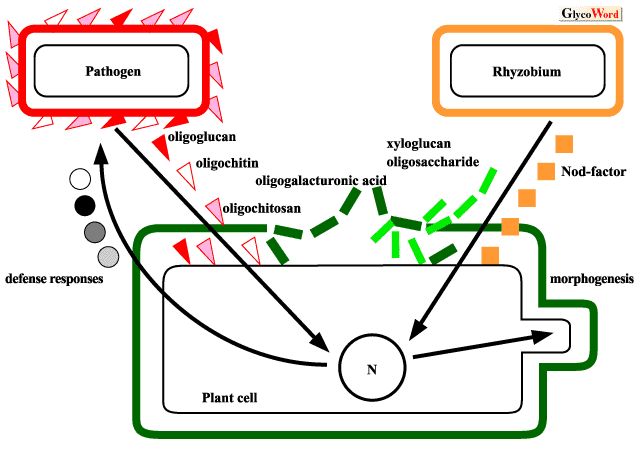|
Oligosaccharide Signaling in Plants
|
 |
|
 |
Plants have the ability to recognize some oligosaccharides or their derivatives as a potent biological signal and initiate various cellular responses which lead to important biological phenomena such as defense reactions or differentiation. Albersheim et al. proposed the name "oligosaccharins" for such biologically active oligosaccharides.
The most developed area in this field are studies on the function of oligosaccharides in plant-microbe interactions. Oligosaccharide function in defense responses to microbial attack has been studied extensively. It has been shown that various plant cells can respond to fragments of chitin, chitosan, or beta-1,3-, 1,6-glucan and initiate defense reactions. It seems quite reasonable to use these oligosaccharides as a signal molecule to distinguish self and non-self and initiate defense responses because these polymers do not exist in plants but are widely distribute among various fungi including pathogens. The idea to use such differences in cell surface carbohydrates as a tool to distinguish self and non-self may further be supported by the fact that various enzymes and lectins which degrade or recognize these polysaccharides are an important constituent of defense machinery in various organisms including plants.
Fragments of pectin (oligogalacturonides, OGA) can also induce defense reactions in plants. In this case, the degradation of the cell surface of the host plant by invading pathogens can be interpreted to generate the warning signal. It has been shown that some plants produce a polygalacturonase-inhibiting protein which may serve to prevent further degradation of OGA by pathogenic polygalacturonase to maintain the suitable size of OGA as the warning signal.
In the case of symbiotic interaction between legumious plants and rhizobium bacteria, lipochitin oligosaccharides (Nod-factors) produced by rhizobium induce the diffferentiation of host plant cells which is important for the infection as well as the development of nodules. The structures of Nod factors (size of chitin oligosaccharide backbone, type of fatty acid, presence of sulfation or other sugars) are different from each other depending on the origin of rhizobium and such differences are very important in determining the host-specific interaction in the symbiosis.
The molecular machinery involved in the perception and transduction of oligosaccharide signals in these systems has been studied. In some cases, purification of the receptor molecule for the oligosaccharides and molecular cloning of their genes have been reported.
Concerning the regulation of growth or differentiation, efforts have mostly focused on the possible function of oligosaccharides derived from plant cell wall polysaccharides, with the exception of the role of Nod factors in nodule development. Oligogalacturonides from the backbone of pectic polysaccharides have been reported to regulate the differentiation in some model systems, in addition to the potential role in defense responses. Specific fragments of xyloglucan have also been reported to show anti-auxin or auxin-like activity depending on the concentration. Ferulated arabinoxylan fragments were reported to inhibit the extension growth induced by auxin. It has also been reported that N-linked oligosaccharides from glycoprotein play the important roles in the redifferentiation of plant cells. Some cell wall polysaccharides contain extremely complicated structures and may play a potential role in generating biologically active fragments, but this hypothesis has not yet been proven experimentally.
The molecular machinery involved in the perception and transduction of oligosaccharides has not been studied in these systems, probably because of the complexity of the experimental system.
Plants provide interesting and excellent model systems for the study of glycobiology, especially because simple oligosaccharides rather than glycoconjugates function as a signal molecule in these systems. These studies also raise interesting questions regarding the relationships between defense responses and development/differentiation, as seen in the case of OGA as well as chitin/lipochitin oligosaccharides.
|
|
|

|
|
|
Naoto Shibuya (Department of Biochemistry, National Institue of Agrobiological Resources) |
|
|
|
|
|
| References |
(1) |
CA, Ryan, EE, Farmer: Oligosaccharide signals in plants: A current assessment. Ann. Rev. Plant Physiol. Mol. Biol. 42, 651-674, 1991
|
|
(2) |
F, Cote, MG, Hahn: Oligosaccharins: Structure and signal transduction. Plant Mol. Biol., 26, 1379-1411, 1994 |
|
(3) |
J. Ebel and D. Scheel: Signals in host-parasite interactions. "The Mycota V Part A", Carroll/Tudzynski eds., Springer-Verlag, 1997
|
|
|
|
|
|
| Dec. 15, 1999 |
|
|
|
|
|
|
|



